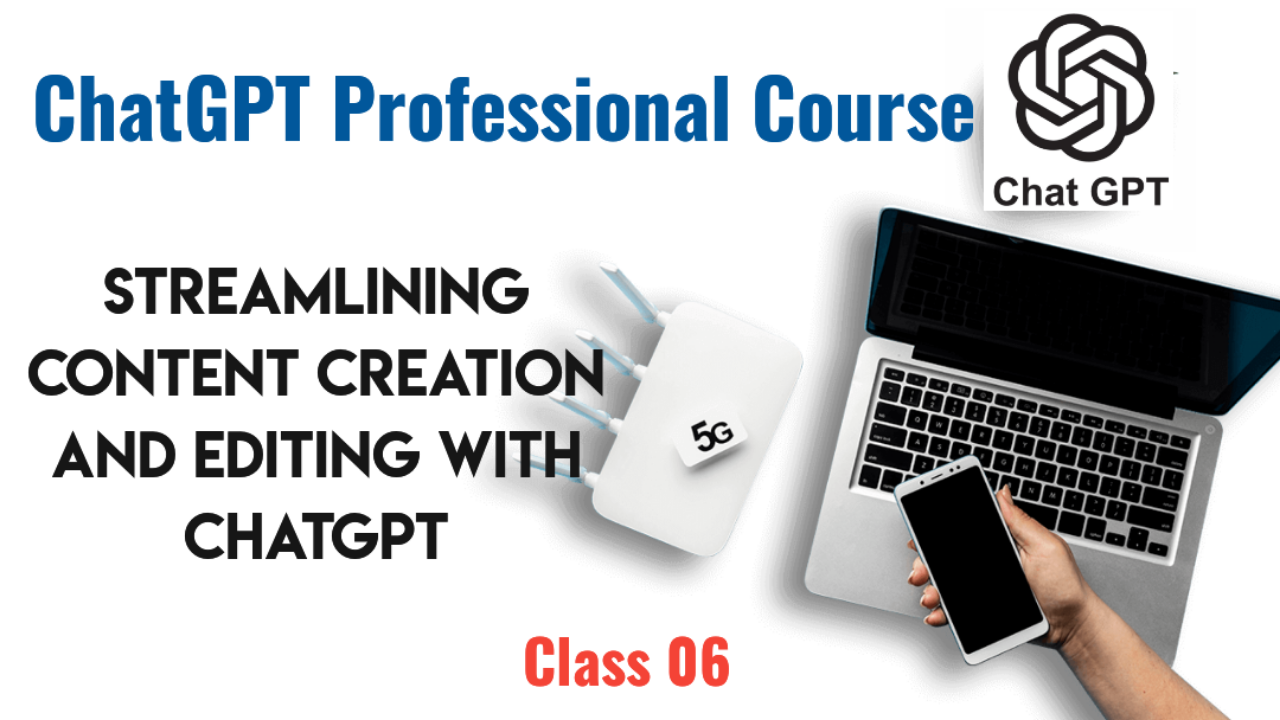Class 6: Content Generation for Marketing and PR Using ChatGPT
1. The Role of AI in Marketing and PR
-
Why AI is Transforming Marketing and PR
AI is revolutionizing how businesses create, distribute, and optimize content. It offers marketers the ability to generate personalized, engaging, and SEO-friendly content at scale. In public relations (PR), ChatGPT can assist in drafting press releases, media responses, and communication strategies that resonate with audiences and reflect brand values.
-
How ChatGPT Fits into Marketing and PR
ChatGPT is an excellent tool for generating various forms of marketing and PR content, from social media posts to long-form blog articles, newsletters, and press releases. It can save time by automating repetitive tasks and ensuring the messaging aligns with the brand’s voice.
2. Types of Marketing Content ChatGPT Can Create
-
Social Media Posts
Use ChatGPT to generate creative and engaging social media posts tailored to different platforms such as Twitter, LinkedIn, Instagram, and Facebook. For example, it can help create posts that promote upcoming events, share customer testimonials, or highlight new products. -
Blog Posts and Articles
ChatGPT can write long-form blog articles that are informative, SEO-optimized, and engaging. It can be used to write product reviews, industry analysis, how-to guides, or thought leadership pieces that demonstrate your expertise in the market. -
Email Campaigns
Generate persuasive email campaigns targeting specific audiences, whether it’s for product launches, promotional offers, or client onboarding. ChatGPT can craft email sequences that nurture leads, drive conversions, or maintain customer engagement. -
Ad Copy
Whether for Google ads, Facebook ads, or other platforms, ChatGPT can assist in creating attention-grabbing ad copy that converts. It can generate multiple variations of headlines and body text to test what works best for different audiences.
3. Public Relations Content Creation
-
Press Releases
ChatGPT can help draft professional and concise press releases for new product launches, company announcements, partnerships, or other newsworthy events. Ensure that the press release follows the standard structure, including the headline, lead paragraph, body content, and contact information. -
Crisis Communication
In times of crisis, businesses need to respond swiftly and carefully to manage their public image. ChatGPT can assist in drafting statements or responses that address the situation while maintaining the brand’s reputation. -
Media Pitches
Use ChatGPT to create personalized media pitches that grab the attention of journalists or influencers. It can help with crafting the perfect pitch that highlights the key news or unique angle you want to convey.
4. Optimizing Content for SEO Using ChatGPT
-
SEO-Friendly Copywriting
ChatGPT can help generate content that is optimized for search engines by incorporating relevant keywords naturally within the text. By generating SEO-friendly headlines, meta descriptions, and subheadings, you can increase your website’s visibility. -
Topic Research and Keyword Suggestions
ChatGPT can help generate ideas for content topics based on your industry or target audience. It can also suggest relevant keywords to target based on current search trends, ensuring that the content remains competitive. -
Creating Content Pillars and Clusters
ChatGPT can assist in creating pillar content that serves as the cornerstone of your marketing strategy. From there, it can generate cluster content (related articles or blogs) that link back to the pillar, improving SEO through internal linking and topic depth.
5. Steps to Use ChatGPT for Marketing and PR
-
Step 1: Define the Content’s Purpose
Before generating content with ChatGPT, be clear on its purpose. Is it to educate, inform, entertain, or persuade? Define the desired action you want the reader to take, such as signing up for a newsletter, making a purchase, or sharing the content. -
Step 2: Provide Context in Prompts
The more context you provide to ChatGPT, the better the output. When generating content, include details such as the target audience, the tone you want to convey, and any specific points you want covered. -
Step 3: Edit and Refine the Output
While ChatGPT generates excellent drafts, it’s essential to review and edit the content to ensure it aligns with your brand’s voice, values, and messaging. Fine-tune the text, add personalized touches, and check for accuracy. -
Step 4: Test and Measure Performance
After publishing your ChatGPT-generated content, track its performance using analytics tools. Measure key metrics like engagement rates, click-through rates (CTR), and conversion rates to see how well the content resonates with your audience.
6. Example Marketing and PR Content
-
Example 1: Social Media Post for a Product Launch
"We’re thrilled to introduce our newest product – [Product Name]! It’s designed to [benefit]. Check it out now and get [special offer]! Click the link to learn more [Link]. #NewProduct #Innovation #SpecialOffer" -
Example 2: Press Release for a New Partnership
"[Company Name] Announces Strategic Partnership with [Partner Name] to Drive [Goal]. This collaboration will enable both companies to [achieve benefit], offering enhanced [service/product] to customers. Read more about this exciting partnership here [Link]." -
Example 3: Email Campaign for a Seasonal Sale
"Get ready for the biggest sale of the season! Starting [Date], enjoy up to [percentage]% off on [products/services]. Don’t miss out on these limited-time deals! Shop now and save big [Link]."
7. Practical Exercise
- Exercise:
Choose a product, service, or event from your business. Use ChatGPT to generate a press release, a social media post, and an email campaign promoting it. Review the outputs and refine them for clarity, tone, and engagement.
8. Homework
- Homework Assignment:
Select one of your current marketing or PR campaigns. Use ChatGPT to generate content (such as blog posts, social media posts, or press releases) for that campaign. Compare the AI-generated content with any previous versions you’ve written, and evaluate which is more effective in achieving your goals.
In the next class, we will explore using ChatGPT for data analysis and business insights, where we’ll cover how to use AI to process large datasets and generate actionable insights to drive business decisions.





















